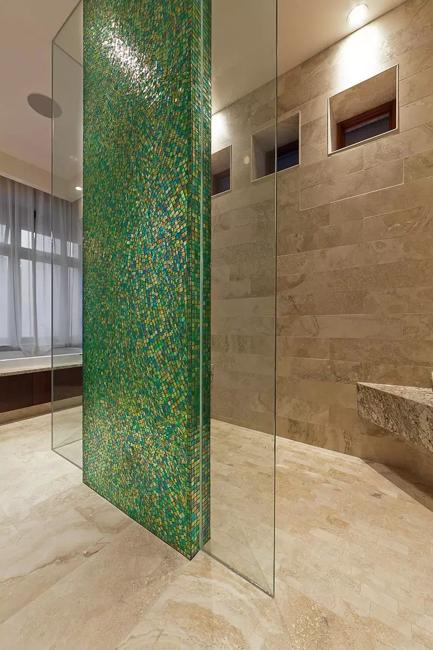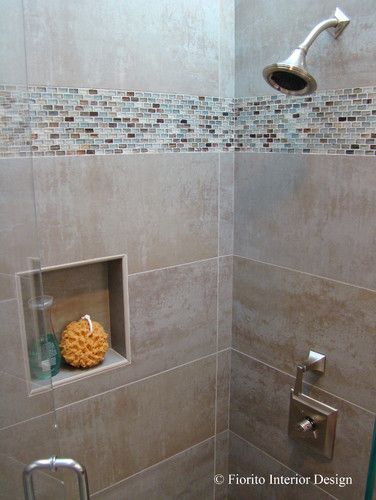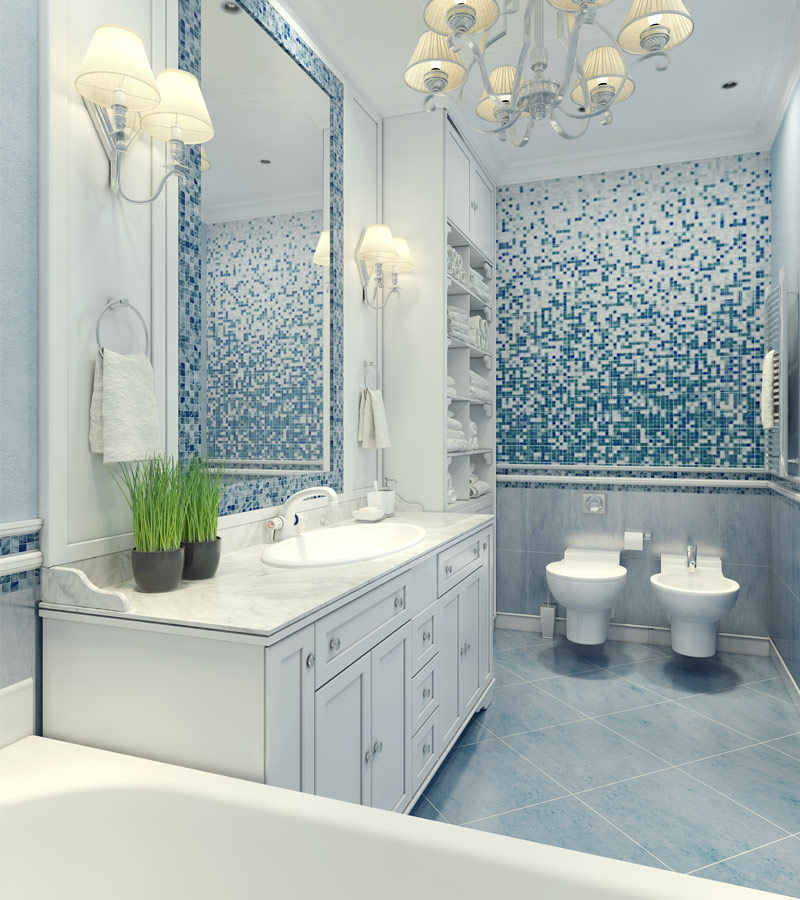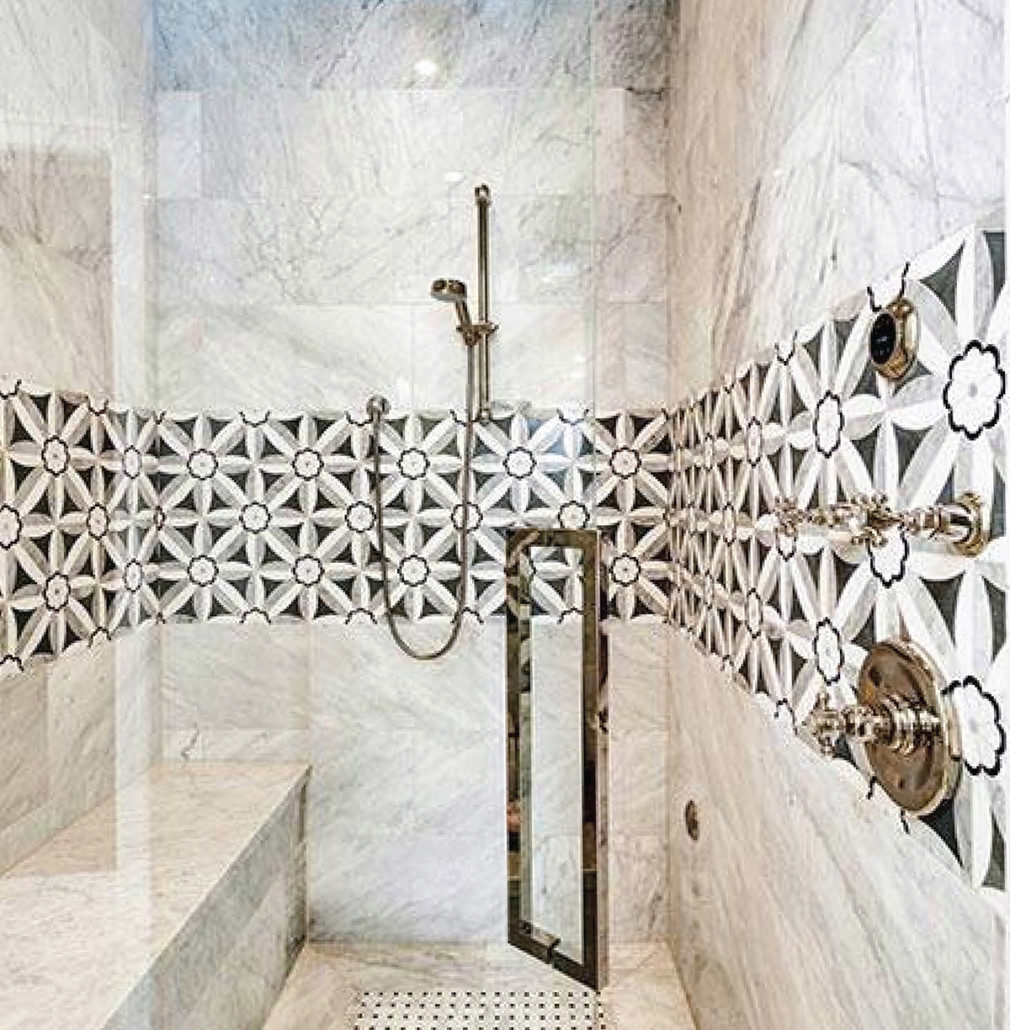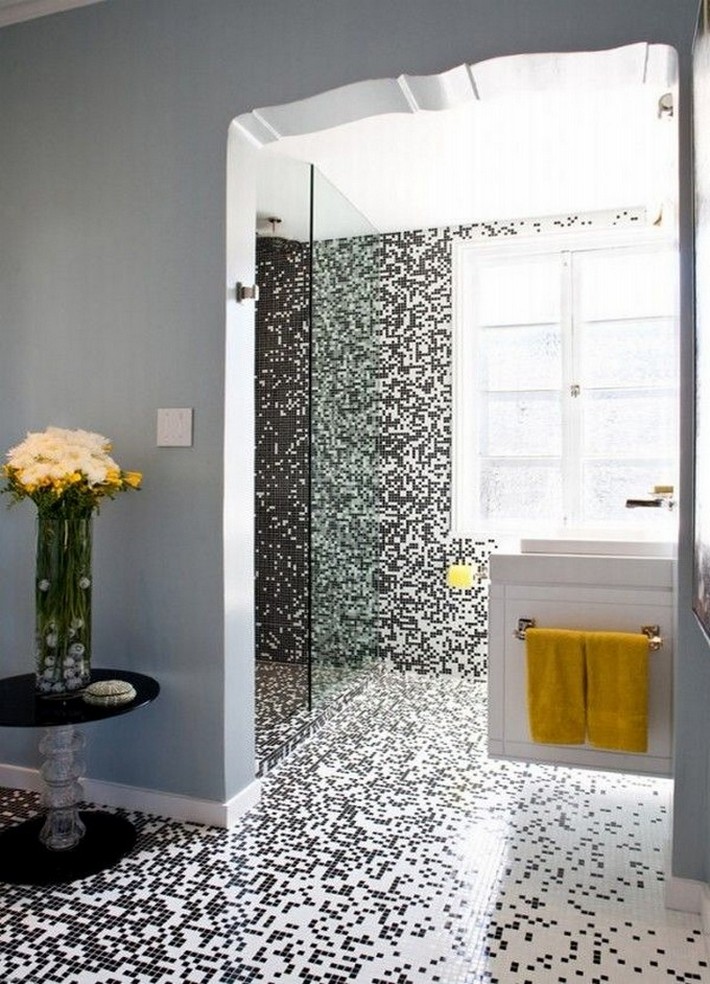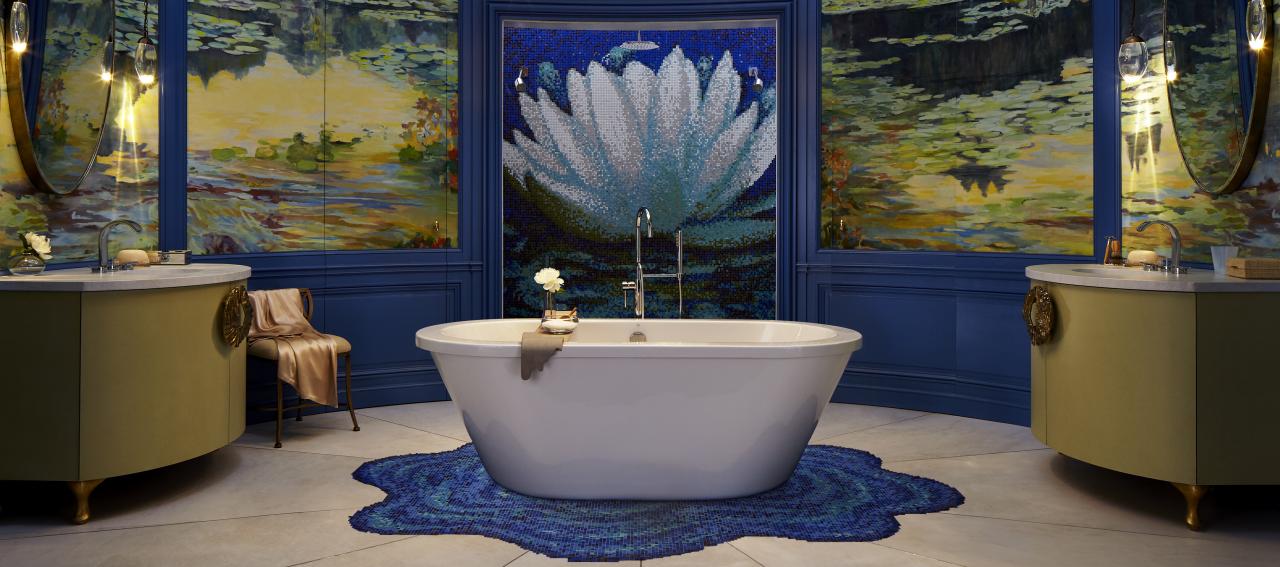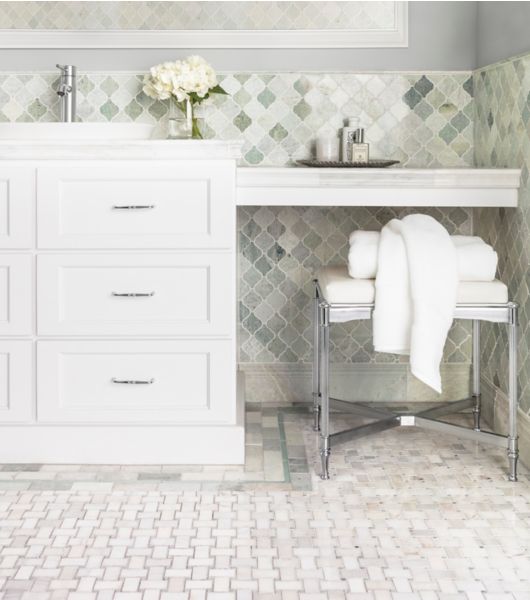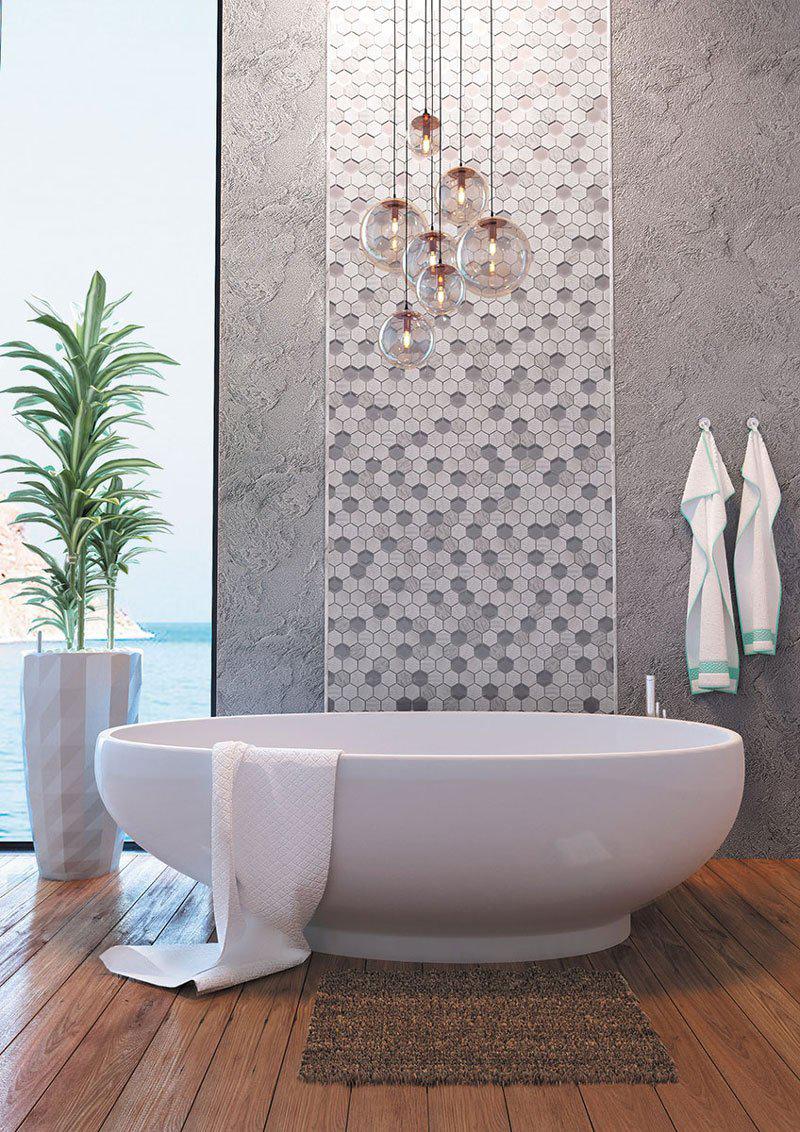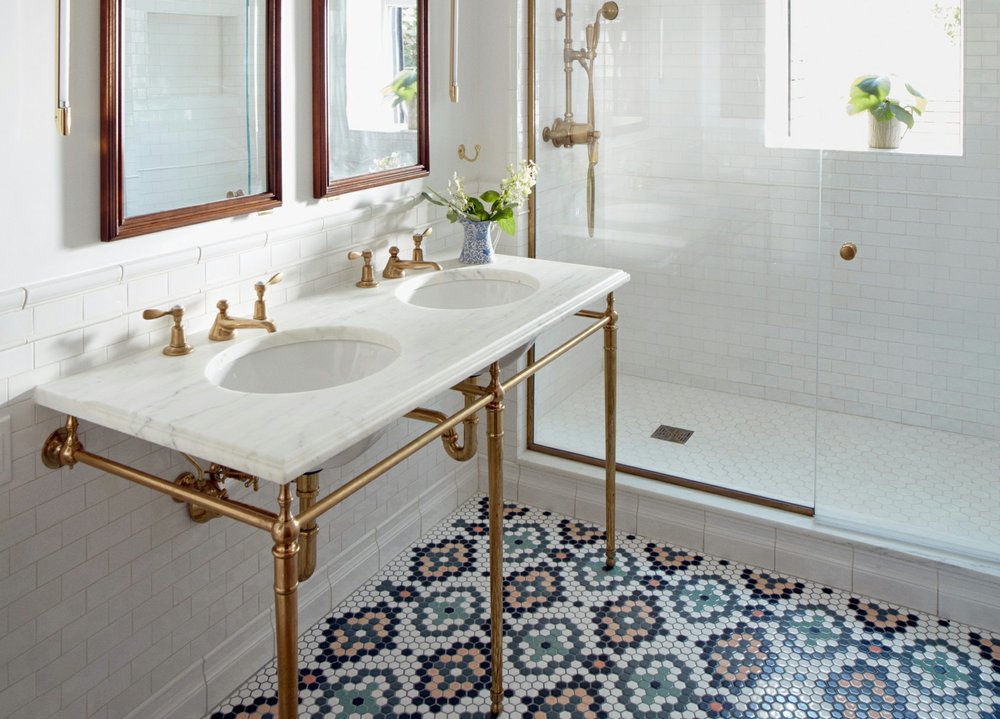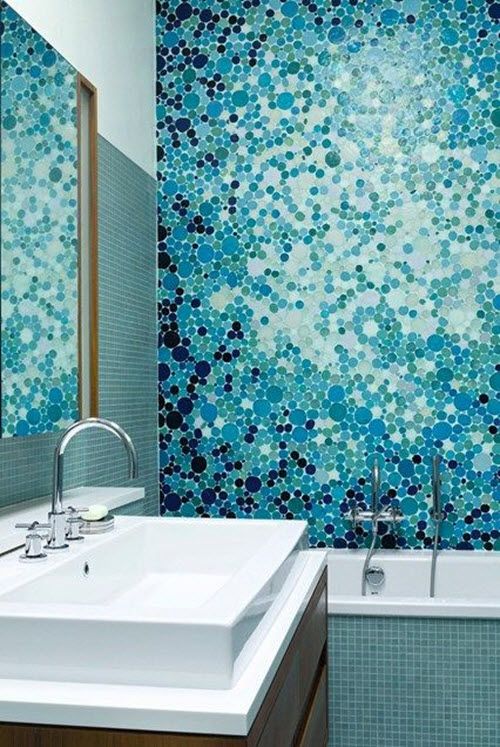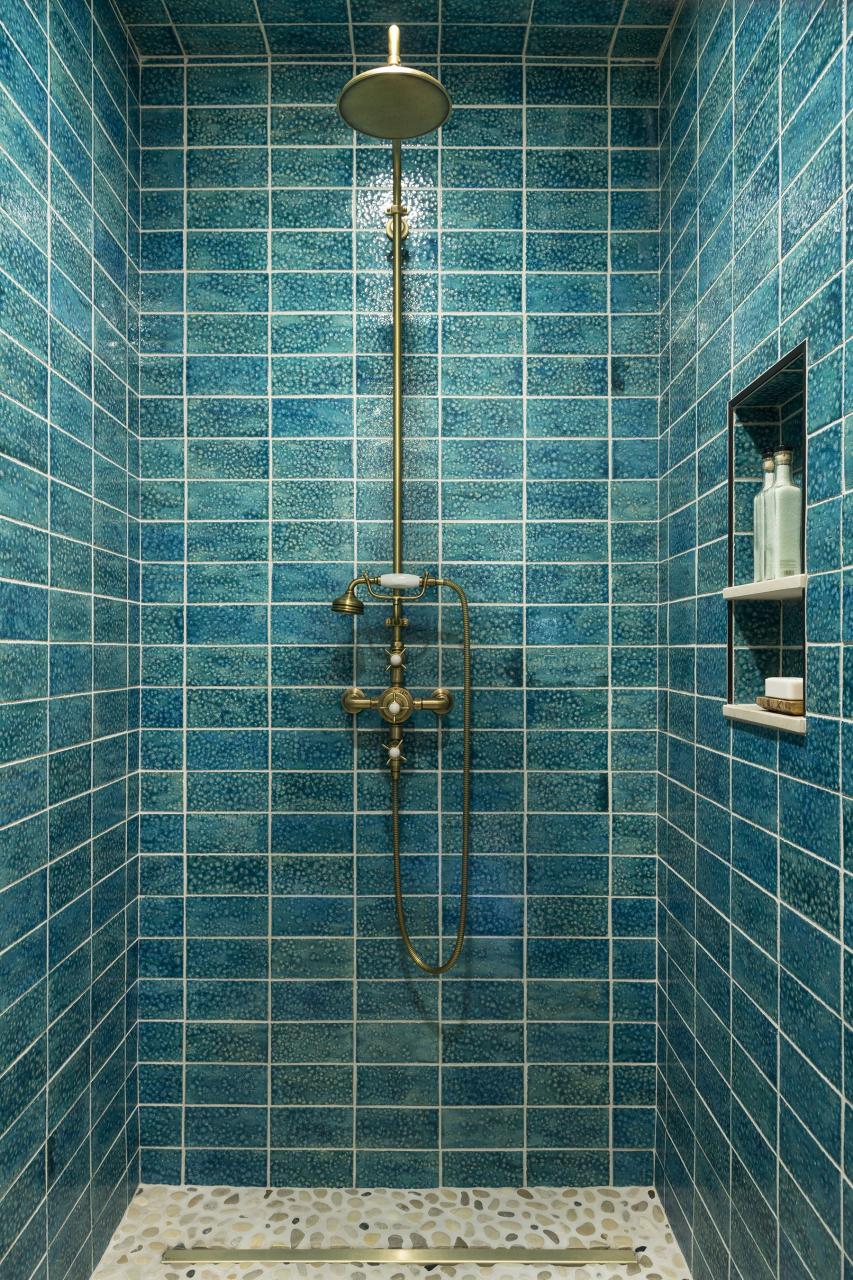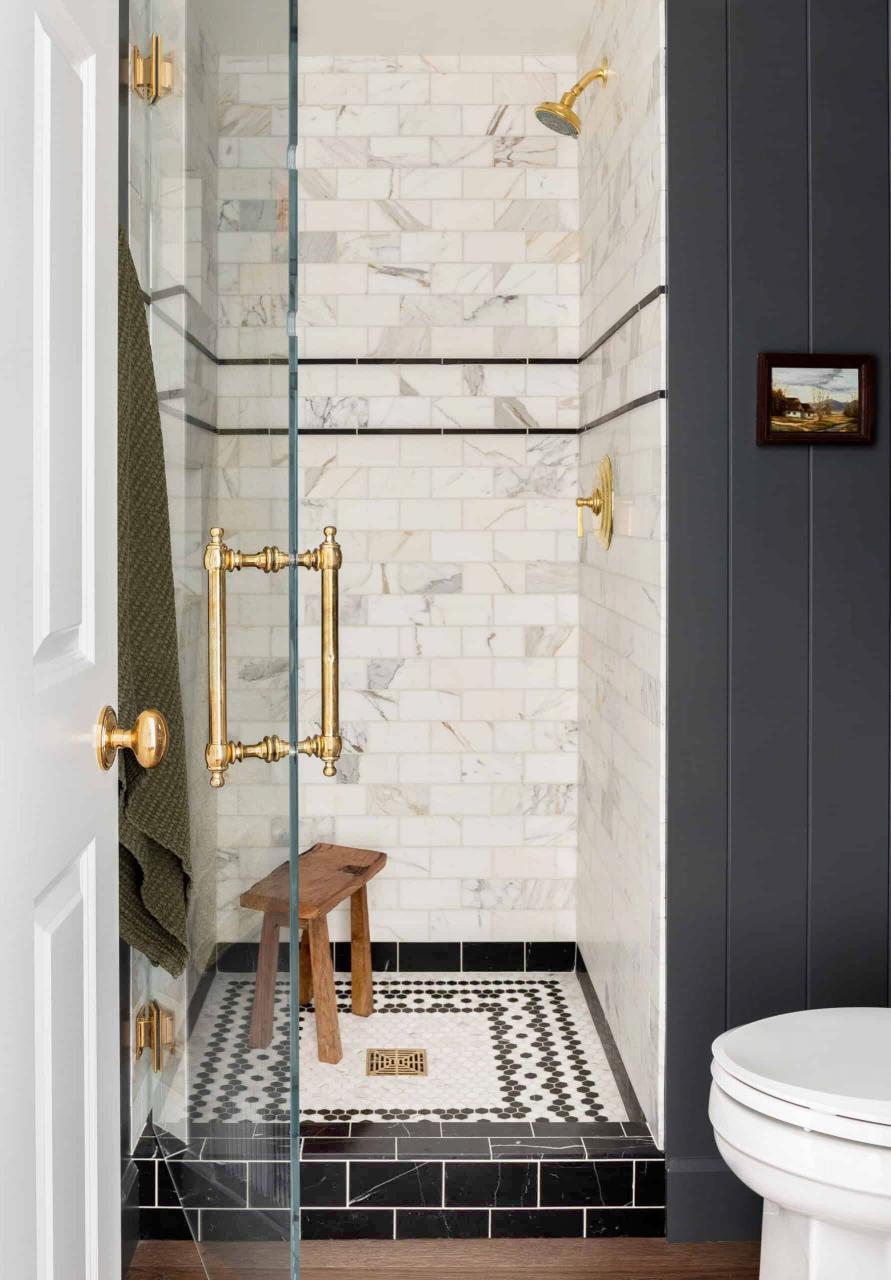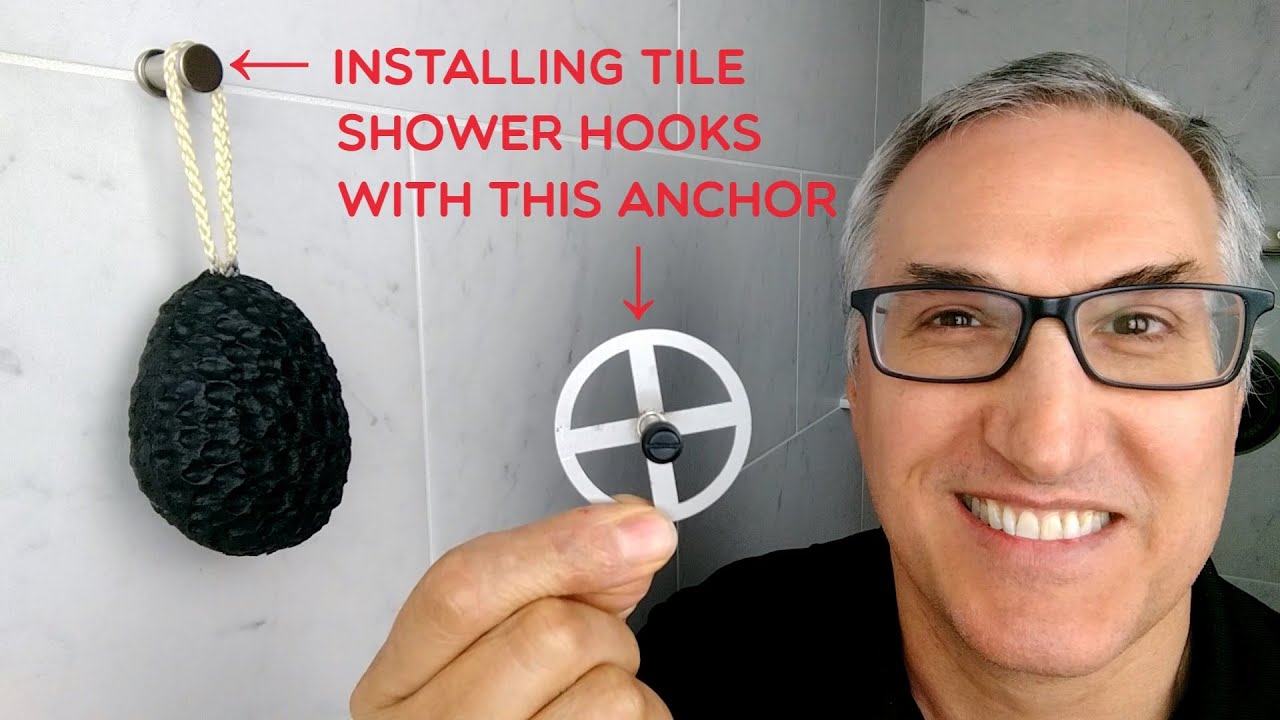Why Choose Mosaic Tiles for Your Bathroom?
When renovating a bathroom, one of the most important decisions you’ll make is choosing the right tile. Mosaic tiles have become increasingly popular for their versatility and style. They offer a distinct aesthetic and functionality that can transform any bathroom into a personalized space of beauty and elegance. But why should you specifically choose mosaic tiles for your bathroom? Here’s why.
- Endless Design Possibilities One of the main reasons to choose mosaic tiles is their flexibility in design. These small tiles come in various shapes, sizes, colors, and materials, allowing you to craft a design that’s unique to your space. Whether you’re aiming for a contemporary vibe or something more classic, mosaic tiles allow you to express your style without limits.
- Perfect for Small Spaces Bathrooms, especially in smaller homes or apartments, can often feel cramped. Mosaic tiles are ideal for smaller bathrooms because their intricate designs and patterns can create the illusion of a larger, more open space. A well-planned mosaic tile pattern can visually expand a room, making it appear airier and more spacious.
- Great for Accents and Borders If you’re not looking to tile the entire bathroom with mosaics, you can still use them strategically. Mosaic tiles make for excellent accent walls, backsplashes, or border designs. You can pair them with larger tiles to break up monotony or to add a pop of color and texture that gives your bathroom an eye-catching focal point.
- Durability and Longevity When it comes to durability, mosaic tiles are a solid choice. Made from materials like ceramic, glass, or natural stone, they are built to withstand moisture and the wear and tear that bathrooms endure. Once installed correctly, mosaic tiles can last for years without losing their vibrancy or structure, making them a worthwhile investment.
- Easy to Clean and Maintain The smooth surfaces of mosaic tiles, especially glass varieties, make them easy to clean. Unlike some other bathroom surfaces, they don’t absorb moisture or harbor bacteria, which is crucial in maintaining a sanitary space. Regular cleaning with mild soap and water will keep your mosaic tiles looking new for years to come.
- Eco-Friendly Options Many mosaic tiles are made from recycled materials, especially glass. If sustainability is important to you, opting for eco-friendly mosaic tiles is a great way to enhance the beauty of your bathroom while being kind to the planet. These tiles not only reduce waste but also add an artistic flair with their rich, recycled textures.
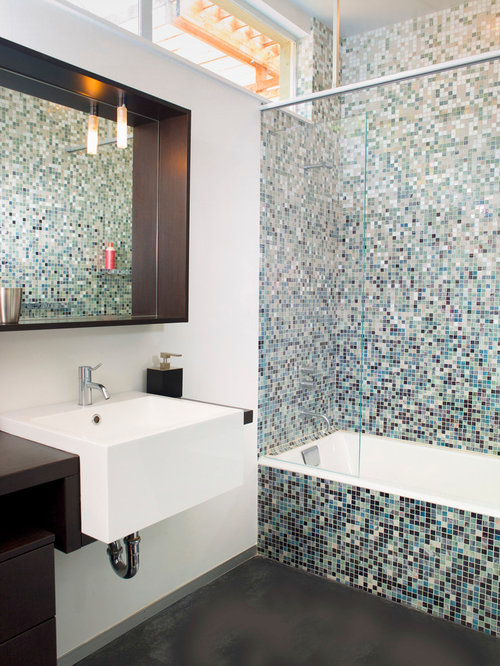
Types of Mosaic Bathroom Tiles: A Quick Overview
Choosing the right type of mosaic tile for your bathroom can feel overwhelming with so many available options. Each type has its unique characteristics that can influence the look, feel, and practicality of your space. To help narrow down your options, here’s a breakdown of some of the most popular types of mosaic bathroom tiles.
Glass Mosaic Tiles Glass mosaic tiles are a popular choice due to their reflective nature, which can brighten up a bathroom by reflecting light and creating a sense of depth. They’re available in various colors and finishes, from clear glass to frosted or iridescent designs. One of the advantages of glass tiles is their moisture resistance, making them perfect for bathroom settings.
Ceramic Mosaic Tiles Ceramic tiles are a classic choice and are often favored for their affordability and durability. Ceramic mosaic tiles come in an array of colors and can be glazed for a glossy finish or left unglazed for a more natural look. They’re also easy to clean and maintain, making them a practical choice for high-traffic bathrooms.
Porcelain Mosaic Tiles For those looking for durability, porcelain mosaic tiles are a great option. These tiles are denser than ceramic and have a lower water absorption rate, making them highly resistant to moisture and stains. Porcelain tiles also come in various textures, including wood or stone-like finishes, giving you the option to mimic more expensive materials at a fraction of the cost.
Natural Stone Mosaic Tiles If you’re after a more earthy and luxurious feel, natural stone mosaic tiles are worth considering. These tiles can be made from materials like marble, granite, or travertine and often feature unique patterns due to the natural variations in the stone. They add a sense of elegance and texture to your bathroom but may require more maintenance compared to other options.
Metal Mosaic Tiles Metal mosaic tiles are becoming increasingly popular for modern, industrial-style bathrooms. They’re typically made from stainless steel, copper, or aluminum, and add a sleek, reflective surface to the space. While metal tiles are durable, they can be more challenging to clean if water stains or fingerprints accumulate, so maintenance is key.
Pebble and River Rock Mosaics For those who want to bring a natural, spa-like feel into their bathroom, pebble and river rock mosaic tiles are an excellent choice. These tiles are made from small, rounded stones arranged in a mosaic pattern. They create a textured surface that’s perfect for shower floors or accent walls and bring a calming, earthy vibe to any bathroom.
Creative Layout Ideas for Mosaic Tile Designs
Once you’ve chosen the type of mosaic tile for your bathroom, the next step is figuring out how to lay them out. The layout of your tiles can drastically impact the overall aesthetic of your bathroom. Let’s discuss some creative layout ideas that can bring your mosaic tile designs to life.
Herringbone Pattern The herringbone pattern is a classic layout that adds a touch of sophistication to any bathroom. In this design, tiles are arranged in a zig-zag pattern, creating a sense of movement and flow. It’s particularly effective when used with rectangular mosaic tiles and can add visual interest to floors or walls without overwhelming the space.
Chevron Design Similar to the herringbone pattern, the chevron design is another trendy layout option. Instead of the tiles being laid at 90-degree angles, they’re cut at an angle to form a continuous “V” shape. This design works beautifully on bathroom floors or as a striking feature wall behind a vanity or shower.
Hexagon Mosaic Layout Hexagon tiles have been making a comeback in modern bathroom designs. Their geometric shape creates a clean, organized look, and they’re available in a range of sizes and colors. Whether you use them for a backsplash, floor, or shower wall, hexagon mosaics bring a contemporary, minimalist vibe to your space.
Random Mixed Patterns If you’re a fan of eclectic design, mixing different mosaic tile shapes, sizes, and colors can create a one-of-a-kind pattern. For instance, you can combine small square tiles with larger rectangles or even throw in some glass accents for a burst of shimmer. This random mix brings an artistic, handcrafted feel to your bathroom.
Border or Frame Accent Mosaic tiles don’t have to dominate the entire wall or floor. One clever way to incorporate them is by using them as a border or frame around larger tiles. This adds just a touch of mosaic flair without overwhelming the space. You can outline a mirror, bathtub, or shower area with a mosaic border to create a subtle yet stylish accent.
Mosaic Floor Medallions If you want to make a bold statement, consider incorporating a mosaic medallion into your bathroom floor. These intricate designs often feature a central motif surrounded by detailed patterns, much like a rug. A mosaic medallion can serve as the focal point of your bathroom, adding a touch of grandeur to the overall design.
Using Color to Improve Your Mosaic Bathroom Look
Color plays a huge role in transforming any bathroom, and when it comes to mosaic tiles, the choices are nearly endless. Choosing the right color scheme for your mosaic tiles can completely elevate the look and feel of your bathroom, whether you want something bold and daring or serene and calming. Let’s explore how to use color effectively to bring your mosaic bathroom design to life.
Monochromatic Elegance If you prefer a minimalist or modern aesthetic, sticking to a monochromatic color scheme is a fantastic choice. This involves using varying shades of a single color to create depth and interest. For example, you could choose different shades of gray or blue to create a soothing yet sophisticated space. Monochromatic designs often create a clean, sleek look that doesn’t overwhelm the senses, making it a great choice for smaller bathrooms.
Bold and Vibrant Color Pops For those who want their bathroom to make a statement, incorporating bold colors into your mosaic tile design can turn the space into a real showstopper. Bright colors like teal, coral, or mustard yellow can be used sparingly in an accent wall or border, giving your bathroom a lively and energetic vibe. Bold colors also work well in modern or eclectic spaces, where you want to bring personality and creativity to the forefront.
Natural Earth Tones for a Calming Retreat Earthy tones such as beige, sand, brown, and green create a natural, spa-like atmosphere. These colors can evoke a sense of calm and relaxation, making them ideal for a bathroom space where you want to unwind. Pairing neutral tones with natural stone mosaic tiles can enhance the organic feel, creating a bathroom that feels like an oasis of tranquility. This design approach works wonderfully in larger bathrooms or those with plenty of natural light.
Contrasting Color Combinations If you’re feeling adventurous, you can play with contrasting color combinations to add drama and dimension to your bathroom. A black-and-white mosaic tile pattern is a timeless choice that adds a bold, graphic punch to any bathroom. Alternatively, pairing dark, rich colors like navy or charcoal with lighter tones like soft pink or gold can create a striking contrast that feels both elegant and modern.
Gradient and Ombre Effects One creative way to incorporate color into your mosaic design is through gradient or ombre effects. This involves blending different shades of a single color to create a smooth transition from light to dark, or vice versa. For example, you could start with a pale blue at the top of your shower wall and gradually fade into a deep navy at the bottom. This design approach adds a touch of artistry and sophistication, creating a dynamic look that’s sure to impress.
Metallic Accents for Glamour Incorporating metallic accents into your mosaic tile design is a great way to add a touch of glamour to your bathroom. Tiles with metallic finishes—such as gold, silver, or bronze—reflect light beautifully and create a luxurious, high-end feel. You can use metallic tiles as accents within a larger design or go all out with a shimmering, full wall of metallic mosaic. This look is perfect for those who want to make their bathroom feel more like a luxury spa or hotel suite.
Mosaic Tile Accent Walls: Bold Statements for Small Spaces
Incorporating an accent wall into your bathroom can add character and style, especially if you’re working with a smaller space. Mosaic tiles are the perfect medium for creating an eye-catching accent wall that serves as a focal point. With an array of styles and patterns to choose from, mosaic tile accent walls offer endless design possibilities. Here’s why an accent wall made of mosaic tiles can be the star of your small bathroom.
Maximizing Visual Impact In a small bathroom, it’s important to make a big impact without overcrowding the space. An accent wall made from mosaic tiles draws the eye and creates a bold visual statement. Whether you choose a bright, colorful design or a subtle, monochromatic look, mosaic tiles can create a dramatic effect that enhances the overall style of the room.
Highlighting Key Areas Accent walls are most effective when they highlight a specific area of the bathroom. One common spot for a mosaic tile accent wall is behind the vanity or mirror, where it frames the space beautifully and creates a stylish backdrop. Another option is to install the mosaic tiles in the shower or bathtub area, making it the centerpiece of the room.
Adding Texture and Depth Mosaic tiles inherently add texture to any surface they’re applied to, which can be especially beneficial in smaller bathrooms. By incorporating an accent wall with textured or patterned mosaic tiles, you create depth and interest, making the room feel more dynamic. This can make even the smallest bathroom feel layered and thoughtfully designed.
Using Reflective Surfaces to Enhance Light Small bathrooms often lack natural light, but mosaic tiles can help brighten the space. Glass or metallic mosaic tiles are especially effective at reflecting light, making the room feel larger and more open. Installing these reflective tiles on an accent wall can enhance the room’s brightness while adding a touch of modern sophistication.
Creating a Spa-Like Atmosphere If you want to transform your bathroom into a serene, spa-like retreat, a mosaic tile accent wall can help you achieve that vibe. Opt for neutral, earthy tones or natural stone tiles to evoke a sense of calm and relaxation. The intricate patterns of mosaic tiles mimic the look of high-end spas, instantly elevating the atmosphere of your bathroom.
Playing with Geometric Patterns For a more contemporary or artistic look, consider using geometric mosaic tiles for your accent wall. Bold patterns like hexagons, chevrons, or intricate designs can make the wall a piece of art in itself. These designs can break up the simplicity of a small bathroom and add a modern, edgy feel without overwhelming the space.
How to Mix and Match Mosaic Tiles for a Custom Look
Mixing and matching mosaic tiles is a fun and creative way to design a truly unique bathroom. By combining different materials, colors, and patterns, you can craft a space that reflects your personality and design preferences. Here are some strategies to help you successfully mix and match mosaic tiles for a one-of-a-kind bathroom.
Start with a Base Tile The key to mixing and matching tiles is to start with a base. Choose a primary tile that will cover the majority of your bathroom’s surfaces—this could be a neutral-colored ceramic tile or a more textured natural stone. Once you have a base, you can layer in other mosaic tiles that complement or contrast with the base, adding variety without making the design too chaotic.
Use Color Theory to Guide Your Choices When mixing different mosaic tiles, it’s essential to consider how colors interact. Using a color wheel or basic color theory can help guide your decisions. Complementary colors (those opposite each other on the color wheel) create bold contrasts, while analogous colors (those next to each other) produce a more harmonious effect. Choosing a cohesive color scheme ensures that your design remains visually appealing.
Incorporate Different Textures Mixing tiles of different textures can add dimension to your bathroom design. For instance, you might pair smooth glass tiles with rougher natural stone or matte ceramic tiles with glossy accents. The contrasting textures create depth and visual interest, making the space feel more luxurious and thoughtfully designed.
Balance Bold Patterns with Solids If you’re drawn to bold, patterned mosaic tiles, it’s important to balance them with more solid, neutral tiles to avoid overwhelming the space. Use the bold patterns as accents, such as in a niche, backsplash, or feature wall, while keeping the surrounding tiles simple. This approach allows the intricate patterns to stand out without clashing with other design elements.
Play with Scale Another way to mix and match mosaic tiles is by playing with scale. You can combine larger tiles with smaller mosaic pieces to create a dynamic, layered look. For example, you could use large-format tiles on the floor or walls, with smaller mosaic tiles arranged in borders, niches, or shower floors. The contrast in tile size adds depth and variety to your bathroom’s design.
Create a Cohesive Flow Even when mixing different types of tiles, it’s crucial to maintain a cohesive flow throughout the bathroom. To do this, choose a common element—such as a shared color, material, or finish—that ties the various tiles together. This will prevent the design from feeling disjointed and ensure that your bathroom looks unified and polished.
Tips for Maintaining and Cleaning Your Mosaic Tile Bathroom
Once you’ve invested in beautiful mosaic tiles for your bathroom, it’s essential to keep them looking fresh and vibrant for years to come. While mosaic tiles are generally durable, they do require regular care and attention to maintain their beauty. Here are some practical tips on how to clean and maintain your mosaic tile bathroom, ensuring it remains a stunning feature of your home.
Routine Cleaning is Key Regular cleaning is the best way to keep your mosaic tiles looking their best. A simple solution of warm water and mild soap will do the trick for daily maintenance. Using a soft sponge or cloth, gently wipe down the tiles to remove surface dirt, soap scum, and water spots. Avoid using harsh or abrasive cleaning tools, as these can damage the tile surface, especially if they’re made of delicate materials like glass or natural stone.
Grout Care and Maintenance The grout between your mosaic tiles is just as important to maintain as the tiles themselves. Grout can easily become discolored over time due to moisture, mildew, and soap buildup. To keep your grout clean, regularly scrub it with a toothbrush or small scrub brush using a mild cleaning solution or a mixture of baking soda and water. Sealing your grout every six months can also help prevent stains and mildew, especially in high-moisture areas like the shower.
Preventing Mold and Mildew Bathrooms are naturally humid environments, which makes them prone to mold and mildew growth—particularly in the grout lines of mosaic tiles. To prevent this, ensure your bathroom is well-ventilated by using exhaust fans or opening windows to allow moisture to escape. Wipe down the tiles and grout after each shower to remove excess water. You can also use a mild vinegar solution to wipe away any mildew before it sets in.
Using the Right Cleaners Different types of mosaic tiles require specific cleaning methods. For glass mosaic tiles, avoid harsh chemicals and opt for glass cleaners or a mild soap solution to keep them streak-free and shiny. If you have natural stone tiles like marble or travertine, avoid acidic cleaners (like vinegar or lemon) as they can damage the surface. Instead, use pH-neutral cleaners designed for stone to maintain their natural beauty without causing etching or discoloration.
Dealing with Stains and Tough Spots Despite regular cleaning, stains and tougher spots can still appear over time. For stubborn stains, a baking soda paste (mix baking soda with a bit of water) applied to the area can help lift the stain without damaging the tile surface. Let it sit for a few minutes before gently scrubbing with a soft brush. Avoid using metal brushes or scouring pads, as they can scratch the surface of your tiles.
Seal and Protect Your Tiles While many mosaic tiles, like ceramic or porcelain, are naturally resistant to moisture and staining, others, such as natural stone, benefit from a sealant. Applying a high-quality tile and grout sealer every 6 to 12 months can protect the tiles from water damage and stains, especially in areas like the shower. Be sure to follow the manufacturer’s instructions for application, and always test the sealer on a small area before applying it to the entire surface.
Bathroom Mosaic Tile Designs
Mosaic Tile – The Tile Shop
Textured Wooden Beige And Glass Hexagon Mosaic Tile
Back in tile: Classic mosaic flooring from yesteryear is enjoying
Mosaic tile ideas mosaic tiles, mosaic, tile bathroom
Related Posts:
